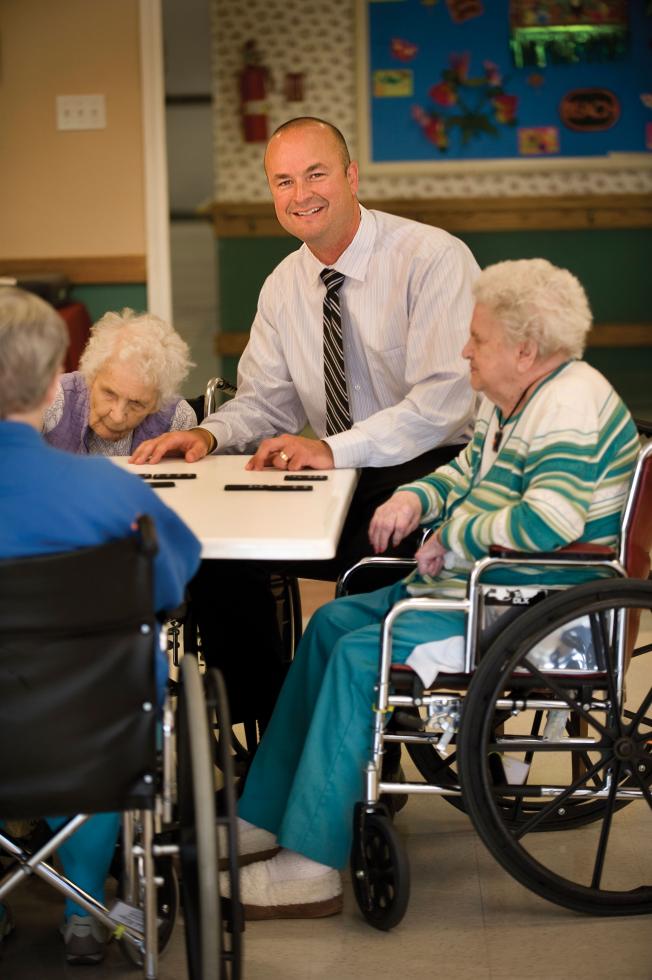When a family member needs more care than you’re able to give, you may automatically think they need to be placed in a nursing home. However, that’s not always the case, according to Jason Pollock, administrator of Oak Ridge Health Care Center in Roseville.
When a family member needs more care than you’re able to give, you may automatically think they need to be placed in a nursing home. However, that’s not always the case, according to Jason Pollock, administrator of Oak Ridge Health Care Center in Roseville.
“A good starting point is to work with the doctor to determine what kinds of medications they’re on, what treatments they receive and if they need assistance with the activities of daily living,” Pollock says. “If they don’t need 24-hour help, they could use a lower level of care.”
Assisted-living facilities provide 24-hour care for folks who don’t require a skilled nurse but need meals prepared, medications monitored and assistance with bathing and other daily activities. If your loved one prefers a home-like environment, you might opt for a board-and-care facility in which a residential house has been transformed into a home for up to six seniors.
For those needing medical care, the best choices are often either a skilled nursing home or home health care, in which a registered nurse or licensed vocational nurse visits a private residence to care for the patient. A home health care provider can then send caregivers to assist the person with bathing, dressing, making meals and even cleaning the house.
“One misconception people have is that they can’t stay at home. You can always stay at home,” says Craig Falk, president of Craig Cares, a Roseville-based home-care provider. “The limiting factor may be the cost of care.”
Medicare doesn’t cover much on the long-term care front. In-home caregivers and nurses from home health care agencies must be paid out-of-pocket, and it’s the same for assisted-living facilities and board-and-care homes. Medicare covers only what care is deemed medically necessary in a nursing home, such as physical or intravenous therapy. Some low-income people may qualify for additional financial assistance.
To help determine what type of care your loved one needs, visit the Medicare website (medicare.gov) to use care comparison tools, read health inspection results, nursing home staff data, quality measures and fire safety inspection results. Medicare also ranks nursing homes and offers checklists on how to choose a nursing home or home health care agency.
In addition, Carole Herman, president and founder of Foundation Aiding the Elderly, suggests going to the California Department of Public Health Licensing and Certification Office to research facilities. Public records offer more detailed information on nursing home certification visits, any complaints filed and the resolution of those complaints.
After you’ve decided which nursing homes top your list, visit each facility and talk to the staff, residents and families of residents. Find out if they’re happy with the level of care the residents receive.
“When you walk in, get a sense of what kind of place it is, and use your senses,” Pollock says. “Look at the residents, are they dressed and clean? And what’s the predominant smell?”
Pollock says a clean facility shouldn’t have an overwhelming odor, and the employees should be friendly, well dressed and open to questions.
If home health care is your choice, use the comparison tool on the Medicare website to check out the various agencies in your area, the services offered and the quality-of-care reports. You can also go to the California State Association for Health Services At Home website at (cahsah.org) to find in-home medical care or caregivers who have the CAHSAH Home Care Aide Certification, which requires that companies employ their caregivers, carry general and professional liability insurance and do thorough background checks.
“You also want to ask what skills the caregiver has,” says Ken Erman, administrator of RX Staffing and Home Care, a Sacramento-based home health care agency. “Based on the needs of your loved one, you want to make sure the caregiver has the skills to do the job and you know what kinds of duties they perform.”
A good home health care agency should have a mix of staff with differing qualifications such as registered nurses, licensed vocational nurses, certified nursing assistants and also trained nonmedical caregivers, Erman says. That way, a seriously ill person can have a physical therapist and a nurse come to their home or have someone keep them company and prepare their meals.
For people who don’t need medical care but need help with daily living, nonmedical home care agencies are a good choice. The most important thing to look for is a dependable company with a good reputation that employs and insures its caregivers, says Buck Shaw, owner of Home Instead Senior Care in Sacramento.
“What we look for are caregivers who have a history of dependability and honesty,” Shaw says. “The main thing is they have a compassion for seniors and are doing this for the right reasons.”
The compassion of the caregivers, staff and the quality of care should be the focus when making a decision. Sometimes families get caught up in looking at aesthetics and activities offered, Falk says.
“I wouldn’t spend much time on looking at the newness of a facility and how fancy it is,” Falk says. “That’s not nearly as important as cleanliness and good care.”
Good care means a better quality of life for seniors. Poor care and neglect can result in malnutrition, injury and serious illness. When monitoring your loved one’s care, look for warning signs, such as continually laying in bed, not being dressed or bathed, bed sores, bruises, cuts or poor hygiene, such as unbrushed teeth.
To address concerns or file complaints concerning nursing homes, assisted-living facilities, board-and-care facilities and home health care agencies, contact the National Long-Term Care Ombudsmen in your area. Federally funded in each state, ombudsmen are care liaisons who investigate family and patient complaints and work with facilities and agencies to resolve them. To find the ombudsmen for your area, visit the California Department of Aging website (aging.ca.gov).
Complaints may also be filed with the California Department of Public Health Licensing and Certification Division for nursing homes and home health agencies or with the Department of Health and Human Services for assisted living and board-and-care homes. Home care agencies are not regulated by the state of California but are self-regulated, Shaw says. So any suspected abuse should be reported to Adult Protective Services or the local police.
Types of Care Available
Acute care: Acute-care facilities provide medical and surgical care and/or intensive rehabilitation treatment. Fees for service may be covered by Medicare, Medi-Cal, private pay or another form of health insurance.
Adult day care: These centers are community-based programs that provide nonmedical care to anyone over the age of 18 who needs supervision or assistance with the activities of daily living (eating, dressing, toileting, etc.) on a less-than-24-hour basis. These programs also provide activities and opportunities for social interaction. No transportation or nursing assistance is available. Private pay only; $75 average for a full day of care and an average of $50 for a half-day.
Adult day health care: Licensed, community-based care programs that provide a variety of health, therapeutic and social services designed to serve the specialized needs of people at risk of being placed in a nursing facility. Adult day health care centers have multidisciplinary teams of health professionals providing individualized care plans that can include physical therapy, occupational therapy, speech therapy, social services, recreation, psychological services, transportation, meals and nutritional counseling. Fees can be covered by Medi-Cal if the client has an approved diagnosis; long-term insurance or private pay at an average rate of $75 for a full day of care or $50 for a half-day.
Assisted living: Also called board and care, residential care or group living, assisted-living facilities provide 24-hour personal care and supervision, including meals, assistance with bathing and some activities of daily living. Housekeeping services, monitoring of medications, social activities, support services and assistance in making health care appointments are also offered. Some facilities also offer memory care. Predominantly private pay, some facilities will accept Supplemental Security Income if the client’s income is less than $981 a month. Based on level of care, costs can range $3,000 to $5,000 a month.
Home care: Provided by home health aids or nurses, basic home care is nonmedical assistance with basic daily activities like getting in and out of bed, dressing, bathing, eating and using the bathroom. Help with light housekeeping, laundry, shopping and cooking for the client is also typical. Average cost of $20 an hour payable through long-term care insurance or private pay.
Home health care: Offers a wide range of health care services administered in your home by health aids. Skilled home health services can include physical therapy, wound care, injections, intravenous therapy and monitoring of illnesses. On physicians order, these services can be covered by workers’ compensation, HMO, Medicare or private pay.
Hospice: A program that provides palliative and supportive care for the terminally ill. An interdisciplinary team of professionals and volunteers provide coordinated services with a focus on pain management and quality-of-life in the home or institutional setting. Support is provided for both the patient and family members, including follow-up counseling for family members after the loved one’s death. Provided by Medicare, clients disenroll from their HMOs and enroll in hospice.
In-home supportive services: Housecleaning, meal preparation, laundry, grocery shopping, personal care services (such as bathing, grooming and paramedical services), accompaniment to medical appointments and protective supervision for the mentally impaired. Provided by the county, the client’s cost share is based on monthly income and Medi-Cal participation.
Intermediate care: These facilities provide intermittent nursing care and 24-hour supportive care, including adherence to medication regimes, special diets, personal hygiene and some tasks associated with daily living. Few and far between, intermediate care is a private pay or SSI participant-only program.
Memory care: Sometimes used to refer specifically to dementia care, Alzheimer’s care or both, memory care provides intensive supervision and is often the best option for seniors with profound memory loss. Ranging from $4,000 to $7,000 a month, this level of care is private pay only.
Respite care: Short-term care that allows a caregiver free time from caregiving responsibilities. A higher daily rate than day care, the average expense is $175, private pay only.
Skilled nursing: Often referred to as a nursing home or convalescent home, skilled nursing centers provide 24-hour nursing care and general medical management. Nursing, rehabilitation services, social services and activities are available, and sometimes family education and support services are offered as well. Care is provided under the direction of the resident’s physician and payable through Medicare, HMO, private pay, Medi-cal or long-term care insurance.
SOURCE: CALIFORNIA DEPARTMENT OF SOCIAL SERVICES AND ESKATON SENIOR RESIDENCES AND SERVICES
Transitions: Diagnosis
Dilemma
Transitions: Folly
of Youth
Transitions: Road
to Recovery
Recommended For You

Family Values
Negotiating your personal worth as a caregiver
When Shelley Tabar’s father fell off her roof, she became his primary caregiver and subsequently lost nearly half her income.



